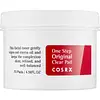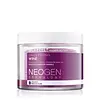What's inside
What's inside
 Key Ingredients
Key Ingredients

 Benefits
Benefits

 Concerns
Concerns

 Ingredients Side-by-side
Ingredients Side-by-side

Water
Skin ConditioningButylene Glycol
HumectantGlycerin
HumectantAlcohol Denat.
AntimicrobialPEG/PPG-17/6 Copolymer
SolventWine Extract
AntioxidantSodium Hyaluronate
HumectantResveratrol
AntioxidantCarbomer
Emulsion StabilisingVitis Vinifera Seed Extract
AntimicrobialRubus Fruticosus Fruit Extract
AstringentRubus Idaeus Fruit Extract
AstringentVaccinium Angustifolium Fruit Extract
Skin ProtectingCoptis Japonica Extract
AntimicrobialTartaric Acid
BufferingGlycolic Acid
BufferingLactic Acid
BufferingTromethamine
BufferingCI 19140
Cosmetic ColorantCI 17200
Cosmetic ColorantCI 42090
Cosmetic ColorantBenzophenone-5
UV AbsorberDisodium EDTA
Phenoxyethanol
PreservativeEthylhexylglycerin
Skin ConditioningPEG-60 Hydrogenated Castor Oil
Emulsifying1,2-Hexanediol
Skin ConditioningParfum
MaskingWater, Butylene Glycol, Glycerin, Alcohol Denat., PEG/PPG-17/6 Copolymer, Wine Extract, Sodium Hyaluronate, Resveratrol, Carbomer, Vitis Vinifera Seed Extract, Rubus Fruticosus Fruit Extract, Rubus Idaeus Fruit Extract, Vaccinium Angustifolium Fruit Extract, Coptis Japonica Extract, Tartaric Acid, Glycolic Acid, Lactic Acid, Tromethamine, CI 19140, CI 17200, CI 42090, Benzophenone-5, Disodium EDTA, Phenoxyethanol, Ethylhexylglycerin, PEG-60 Hydrogenated Castor Oil, 1,2-Hexanediol, Parfum
Ingredients Explained
These ingredients are found in both products.
Ingredients higher up in an ingredient list are typically present in a larger amount.
1,2-Hexanediol is a synthetic liquid and another multi-functional powerhouse.
It is a:
- Humectant, drawing moisture into the skin
- Emollient, helping to soften skin
- Solvent, dispersing and stabilizing formulas
- Preservative booster, enhancing the antimicrobial activity of other preservatives
Butylene Glycol (or BG) is used within cosmetic products for a few different reasons:
Overall, Butylene Glycol is a safe and well-rounded ingredient that works well with other ingredients.
Though this ingredient works well with most skin types, some people with sensitive skin may experience a reaction such as allergic rashes, closed comedones, or itchiness.
Learn more about Butylene GlycolGlycerin is already naturally found in your skin. It helps moisturize and protect your skin.
A study from 2016 found glycerin to be more effective as a humectant than AHAs and hyaluronic acid.
As a humectant, it helps the skin stay hydrated by pulling moisture to your skin. The low molecular weight of glycerin allows it to pull moisture into the deeper layers of your skin.
Hydrated skin improves your skin barrier; Your skin barrier helps protect against irritants and bacteria.
Glycerin has also been found to have antimicrobial and antiviral properties. Due to these properties, glycerin is often used in wound and burn treatments.
In cosmetics, glycerin is usually derived from plants such as soybean or palm. However, it can also be sourced from animals, such as tallow or animal fat.
This ingredient is organic, colorless, odorless, and non-toxic.
Glycerin is the name for this ingredient in American English. British English uses Glycerol/Glycerine.
Learn more about GlycerinPeg-60 Hydrogenated Castor Oil comes from hydrogenated castor oil. It is a solubilizer and emulsifier.
As a solubilizer, it helps dissolve ingredients into a water-based version. It is also an emulsifer. Emulsifier help prevent oils and water from separating. Both these properties help create evenly-spread and uniform products.
Basically, Peg-60 Hydrogenated Castor Oil helps hold ingredients together.
Learn more about PEG-60 Hydrogenated Castor OilSodium Hyaluronate is hyaluronic acid's salt form. It is commonly derived from the sodium salt of hyaluronic acid.
Like hyaluronic acid, it is great at holding water and acts as a humectant. This makes it a great skin hydrating ingredient.
Sodium Hyaluronate is naturally occurring in our bodies and is mostly found in eye fluid and joints.
These are some other common types of Hyaluronic Acid:
Learn more about Sodium Hyaluronate